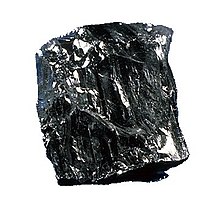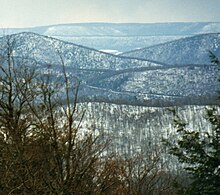Geology of Pennsylvania


The Geology of
A majority of the rocks in Pennsylvania exposed at the surface are
Pleistocene
A rock with high economic value from Pennsylvania is anthracite coal. Before mining began, there was an estimated 22.8 billion tons of anthracite in Pennsylvania. In 2001, 12 billion tons still remained in the ground, most of which was not economically feasible to mine.[3] American geologists recognized the importance of Pennsylvania's coal region and named the Upper Carboniferous Period the Pennsylvanian Period because of the abundance of coal in the state. Despite this, Celestine was proposed as the state mineral in 2002. The proposal however, was not approved by the state legislature.[4][5]
Pennsylvania is also home to the famous
Atlantic Coastal Plain
One of the smallest physiographic provinces in the state is confined to
Piedmont
The Piedmont in Pennsylvania is divided into three distinct sections: the Piedmont Uplands, the Piedmont Lowlands, and the Gettysburg-Newark Lowlands. Much of the Piedmont is becoming urbanized and developed. Some of the best farmland in the state is in this region, specifically Lancaster and Chester counties.
Piedmont Uplands

This section is characterized by the
Siliclasitc and carbonate deposition continued through the Cambrian and into the Ordovician period. During the Taconic orogeny, more igneous intrusions and metamorphism occurred as the ancestral Taconic Mountains were pushed up. The sediments that were deposited in a sea between an island-arc and the Iapetus eventually were squeezed and deformed along a subduction zone. The sediments deposited in that sea are now located in the Great Valley section. (See below) The sediments placed from the rifting of Rodinia became the roots of the ancestral Taconics and went through their first wave of metamorphism during the Taconic orogeny. Additional waves of metamorphism continued up until the Alleghanian orogeny.[8]
Piedmont Lowlands
The lowlands are underlain primarily by more easily eroded rocks such as limestone, dolomite, and phyllite. These rocks are relatively younger in age than the surrounding uplands and are likely the result of a quiet stretch of shallow sea deposition. Some of the rocks deposited during this time are also found in the Great Valley section but have been separated by the Gettysburg-Newark Lowland section. Relief is low and generally never rises above 700 feet (210 m). Karst terrain is problematic in this section.[2]
Gettysburg-Newark Lowlands
This section is a bit misleading since there are hills as high as 1,200 feet (366 m) in this section. It is separated from the rest of the Piedmont sections due to the distinctive rock types found here. Also called the
Buckingham Valley
A small slice of Paleozoic rocks, mostly carbonates, exists in Buckingham Township. These rocks lie north of the Furlong fault which is an offshoot of the larger Chalfont fault.[11] Buckingham Mountain rises south of the valley and comprises quartzite. The other ridge is less prominent and is underlain by the conglomerates of the Stockton Formation. Karst is a localized problem in this area.
New England
A small and fragmented province in northeastern Pennsylvania called the
Ridge and valley
This region in Pennsylvania, made famous by
South Mountain
South Mountain is the northern tip of the Blue Ridge Mountains. This region is characterized by broad flat ridges with deep narrow valleys. The rocks here are highly metamorphosed igneous and sedimentary rocks with some occasional dolomite. These rocks are Pre-Cambrian in age.[2]
Great Valley
The Great Appalachian Valley is a long broad valley that extends from Canada to Alabama. In Pennsylvania, the valley is known by three names: (listed from north to south) the
Blue Mountain

The Blue Mountain or Blue Ridge region, like the ridgelines to its north and west, is one of a series of near parallel ridges that run for tens of miles, and are equally likely to be called Ridge or Mountain. Hence Blue Mountain is not to be confused with the Blue Ridge Mountains but instead, represents the sharp
The sediments that comprise Blue Mountain were deposited as a result of the highlands that formed after the Taconic orogeny. The first wave of sediments were coarse, gray, and poorly sorted. (The Shawngunk Formation) This combination of depositional features means that the source area was relatively close and deposited in a moist climate. These sediments grade into finer reddish sands and silts, (Bloomsburg Formation) as the source area became more distant and/or less productive. The climate during this time was drier.[2]
Anthracite Upland
Arguably the most complex and most studied section in the
Since the
It would take 150 million years for the mountains of this area to achieve the shapes seen today. These mountains are steep-sided and valleys are canoe-shaped, largely due to the area's complex folded structure. Most of the coal being mined from this section is from the Pennsylvanian-aged formations. Along with the
Anthracite Valley

Detached from the rest of Pennsylvania's anthracite fields, this canoe-shaped valley is also known as the Wyoming Valley and is home to the cities of Scranton and Wilkes-Barre. The largest city in the Wyoming Valley is Scranton, with a population of 77,291. The whole structure of the section is a double plunging syncline with sharp mountain ridges on either side of the valley. The ridges meet just north of Carbondale. The North Branch of the Susquehanna River and the Lackawanna River flow through this valley. Large-scale coal mining and its accompanying industry and railroads have long been abandoned.
Unlike the southern and middle anthracite fields, the anthracite valley has been recently glaciated repeatedly. This action has left many talus slopes at the base of Moosic Mountains, and the soils often contain large boulders that make excavation difficult.
Susquehanna Lowland
This region has also seen its landscape altered by glaciation and the
Appalachian Mountain

Standard long, narrow, and steep-sided ridges with narrow valleys define the state in LANDSAT photos. Many of the valleys have karst features due to carbonate rocks that reside in them. Road-building generally follows the valleys and rarely cuts across the ridges. The Pennsylvania Turnpike used tunnels cut through the ridges rather than scaling the mountain tops. Mount Nittany, Tuscarora Mountain, Jacks Mountain, Wills Mountain, and Sideling Hill are five prominent mountains in this section. The section contains Cambrian- through Pennsylvanian-aged sediments all deposited into the
Appalachian Plateau
This is by far the largest province in the state, and most of the rocks in this region are not folded and faulted and sit relatively flat. However, parts of the Appalachian Plateau appear to be mountainous due to erosion caused by streams and glaciers. In western Pennsylvania, large bituminous coal fields exist in rocks with a similar age as the rocks in the anthracite region. Many of the folds in the province are high amplitude and stretch for miles. In glaciated sections, steep canyons developed and much of the terrain have many glacial features. The drainage pattern in this area is dendritic.
Glaciated Pocono Plateau
The
Glaciated Low Plateau
Considered a part of the Pocono Plateau, this area lies to the north of the Poconos and contains many of the same types of rock. The local relief is less than that of the Pocono region and bounded to the southeast by the Delaware River. The
Glaciated High Plateau
Also an extension of the Catskill Mountains of New York, this section generally has higher elevations than the low plateau section as well as deeper valleys. Younger strata also outcrops in this area with a few minor coal beds. The uplands are rounded or flat along mostly broad hills. An excellent example of the escarpment that divides this section are Ricketts and Ganoga Glen located within Ricketts Glen State Park.
Deep Valleys
This section is home to the
Allegheny Front

The
Allegheny Mountain
This section includes Pennsylvania's highest point,
Waynesburg Hills
Located in the southwest corner of the state, the Waynesburg hills are another major coal-producing area for the state. Much of the 64.4 billion tons of bituminous coal that is remaining in the state resides under these hills in near horizontal beds. The hills are narrow and steep-sided, with some deeper valleys.[3]
Pittsburgh Low Plateau
Another section that is a significant coal producer. It is similar to the Waynesburg hills section except for higher local relief and deeper valleys. Landslides and mine subsidence are common hazards.[3]
High Plateau
This section consists of high, broad, and flat uplands cut by sharp and shallow river valleys. Much of this area was not covered by the Late Wisconsinan glacier, but there is evidence of pre-Wisconsinan glaciers in the area. Along with the Endless Mountains, it is one of the most remote places in the eastern United States.
Northwestern Glaciated Plateau
This section has been influenced by glaciers and many of the valleys cut into the bedrock trend northwestward- in the direction of the retreating glaciers. There are many signs of glaciers including kames, eskers, kettles, and moraines. This section is home to Pennsylvania's largest natural lake, Conneaut Lake as well as one of the longest eskers in the state, West Liberty Esker.[15] Some of the drainage patterns have shifted and only a few of the streams flow into Lake Erie.
Central Lowlands
Along with the Coastal Plain Province, the smallest province in the state, the central lowlands are a part of the Great Lakes area and exist along a glacial escapement adjacent to Lake Erie.
Geologic features
The following is a list of Pennsylvania geologic features noted for their beauty and/or uniqueness.
Periglacial

Glacial
- Archbald Pothole
- Grand Canyon of Pennsylvania
- McConnells Mill State Park
- Moraine State Park
- Presque Isle
- Promised Land State Park
- Ricketts Glen State Park
- Worlds End State Park
Structural

- Bear Valley Strip Mine
- Chickies Rock
- Delaware Water Gap
- Pole Steeple
- Governor Stable
- Ringing Rocks
- The Pinnacle
Rock formations
Pennsylvania has been updating its base geologic map last printed in 1980. New research has shifted the names of several formations and promoted or demoted many different sequences on the stratigraphic chart.
References
- ^ Sevon, W.D. (2000). Physiographic Provinces of Pennsylvania, Map 13. Pennsylvania Geologic Survey. Harrisburg, PA.
- ^ a b c d e f g h Schultz, C.H. ed. (2002) The Geology of Pennsylvania. Special Publication No.1. Pennsylvania Geologic Survey and Pittsburgh Geological Society. [1]
- ^ a b c d Edmunds, W.E., (2002), Coal in Pennsylvania (2nd ed.): Pennsylvania Geological Survey, Educational Series 7, p. 17.
- ^ Pennsylvania Geological Survey: Rocks and Minerals
- ^ Edwin, C., (2003). Celestine, the Proposed State Mineral. Pennsylvania Geology, Pennsylvania Geological Survey, Harrisburg, PA. V 33 n 1.
- ^ D. W. Greenman, D. R. Rima, W. N. Lockwood, and Harold Meisler, Ground-water resources of the Coastal Plain area of southeastern Pennsylvania (1961). 375 p., 22 pls.
- ^ Welcome to John Heinz National Wildlife Refuge at Tinicum
- ^ a b c Blackmer, G.C., (2005). Preliminary Bedrock Geologic Map of a Portion of the Wilmington 30- by 60-Minute Quadrangle, Southeastern Pennsylvania. Pennsylvania Geologic Survey, Open-File Report OFBM-05-01.0.
- ^ Faill, R.T. (2004). The Birdsboro Basin. Pennsylvania Geology, Pennsylvania Geologic Survey, Harrisburg, PA. V 34 n 4.
- ^ Smith, R.C. and Keen, R.C., (2004). Regional Rifts and the Battle of Gettysburg. Pennsylvania Geology, Pennsylvania Geological Survey, Harrisburg, PA. V 34 n 3.
- ^ Glaeser, J. D. (1966). "Provenance, Dispersdal, and Depositional Environments of Triassic Sediments in the Newark-Gettysburg Basin". Pennsylvania Geologic Survey, G43, Harrisburg, Pennsylvania.
- ^ Barnes, J.H. and Smith, R.C., II, (2001). The non-fuel mineral resources of Pennsylvania: Pennsylvania Geological Survey, Educational Series 12.
- ^ a b Oleksyshyn, J. (1982). Fossil Plants From the Anthracite Coal Fields of Eastern Pennsylvania. Pennsylvania Geologic Survey, Harrisburg PA, G72.
- ^ Inners, J. D., 1998, Rocks and ruins of the “Upper Grand”—An illustrated trail guide to the geology and historical archeology of Lehigh Gorge State Park: Pennsylvania Geological Survey, 4th ser., Open-File Report 98–03, 4 p., Portable Document Format (PDF).
- ISBN 0-87842-227-7
